


.
Freshwater habitats
The Fells and Dales freshwater habitats provide year-round interest and include rivers like the Lyvennet and Lune and the many becks (streams) that feed into them. Some of these are seasonal, others ephemeral. There are also ponds and small lakes (tarns), seeps and springs in ancient times some were sacred.
Visitors may enjoy fishing for Brown Trout and Rainbow Trout at Bessy Beck fish
farm. They also sell prepared fish to take away and be cooked at home.
Flowing Water (Lotic habitats)
Moisture from the Atlantic Ocean is the lifeblood of the fells. It arrives in the form of fog, rain, sleet and snow according to the season and some filters through peat, soil and limestone until it reaches impermeable strata, and is forced sideways and emitted through springs like those upwellings that form Sunbiggin Tarn, also at Har Keld (Castlehowe), Crake trees and elsewhere. Some of these were sacred ‘holy wells’ and their memory is preserved in place names like Anna Well and Keld. Rainwater run-off from the moorland and meadows feeds a host of ditches and small clear-running becks which in turn feed rivers Leith and Lyvennet which feed ino the River Eden that runs northwards to flow into the Solway, and the Lune that flows out of the area south through the Lune Gorge. The upper reaches run shallow, fast, clear and sweet and become highly oxygenated with exposure to the air. As they descend, they host an increasing amount of invertebrate wildlife such as the naiads of Mayfly larva, caddisflies, damselflies and dragonflies, also water beetle nymphs and adults and White-clawed Crayfish, in pools you might also see horse-hair worms. Streamlined form and the ability to grasp and hang on are important adaptive qualities in lotic wildlife. Frogs may be encountered in the moist, marshy margins, but aren’t fond of flowing water itself. Fish species include loaches, bullheads, minnows, trout and salmon and sticklebacks. Mosses, algae and higher vascular water plants provide green food and living space for a variety of small creatures. The riparian bird life icludes Wagtails, Dippers, Kingfishers and Grey Herons; and seasonally, the Swallows and Swifts that fly up and down the rivers hawking for flying insects.
Restoration of meanders, surveys and conservation of water bodies and dependent wildlife is
conducted by The Eden Rivers Trust. They also offer opportunities for volunteering.
Volunteer with
Eden Rivers Trust

Freshwater
Water & Westmorland Fells
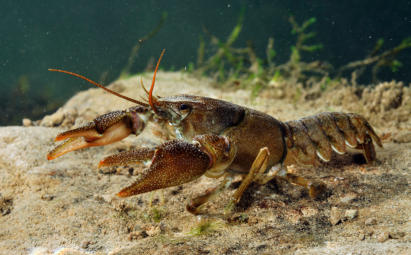
White-clawed Crayfish , loaches, bullheads and minnows live in the fast-
flowing, well-oxygenated limsestone rivers. Image by Linda Pitkin of Eden
Rivers Trust
Still Water (Lentic habitats)
There are also bodies of standing water, even at the higher altitudes and these furnish an altogether different quality of habitat, some are ephemeral, seasonal pools, and others are deeper permanent water bodies like that better serve molluscs like pond snails, some fish, microscopic flora, algaes and volvox, water fleas, water bears and hydra, also as nurseries for frogs, toads and newts and as home for resident and migratory waterfowl.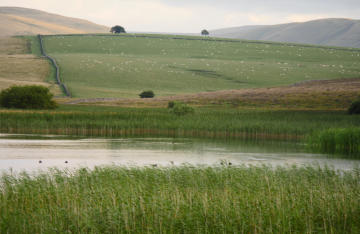

Volunteer with
Eden Rivers Trust
Advertisement
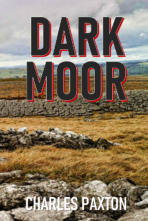
Charles Paxton’s new historical fantasy novel “Dark Moor” is now available
on Amazon Kindle! The book is set in the Westmorland Fells and some other
noteworthy sites in Cumbria.
Please click the above link or the cover image to view the title in a new
window.
© This site and its contents are copyright 2010-22 by C.Paxton and other contributing members of the Westmorland Fells Group.
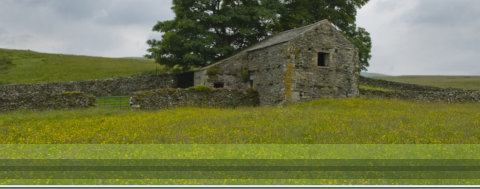

Freshwater

Celebrating Cumbria’s Carboniferous Fells and Dales
Wildlife
Visitors may enjoy fishing for Brown Trout and
Rainbow Trout at Bessy Beck fish farm. They
also sell prepared fish to take away and be
cooked at home.
Flowing Water (Lotic habitats)
Moisture from the Atlantic Ocean is the lifeblood of the fells. It arrives in the form of fog, rain, sleet and snow according to the season and some filters through peat, soil and limestone until it reaches impermeable strata, and is forced sideways and emitted through springs like those upwellings that form Sunbiggin Tarn, also at Har Keld (Castlehowe), Crake trees and elsewhere. Some of these were sacred ‘holy wells’ and their memory is preserved in place names like Anna Well and Keld. Rainwater run-off from the moorland and meadows feeds a host of ditches and small clear-running becks which in turn feed rivers Leith and Lyvennet which feed ino the River Eden that runs northwards to flow into the Solway, and the Lune that flows out of the area south through the Lune Gorge. The upper reaches run shallow, fast, clear and sweet and become highly oxygenated with exposure to the air. As they descend, they host an increasing amount of invertebrate wildlife such as the naiads of Mayfly larva, caddisflies, damselflies and dragonflies, also water beetle nymphs and adults and White-clawed Crayfish, in pools you might also see horse-hair worms. Streamlined form and the ability to grasp and hang on are important adaptive qualities in lotic wildlife. Frogs may be encountered in the moist, marshy margins, but aren’t fond of flowing water itself. Fish species include loaches, bullheads, minnows, trout and salmon and sticklebacks. Mosses, algae and higher vascular water plants provide green food and living space for a variety of small creatures. The riparian bird life icludes Wagtails, Dippers, Kingfishers and Grey Herons; and seasonally, the Swallows and Swifts that fly up and down the rivers hawking for flying insects.
Water & Westmorland Fells
Cumbria Wildlife Trust Hayday Project
Freshwater habitats
The Fells and Dales freshwater habitats provide year- round interest and include rivers like the Lyvennet and Lune and the many becks (streams) that feed into them. Some of these are seasonal, others ephemeral. There are also ponds and small lakes (tarns), seeps and springs in ancient times some were sacred.Still Water (Lentic habitats)
There are also bodies of standing water, even at the higher altitudes and these furnish an altogether different quality of habitat, some are ephemeral, seasonal pools, and others are deeper permanent water bodies like that better serve molluscs like pond snails, some fish, microscopic flora, algaes and volvox, water fleas, water bears and hydra, also as nurseries for frogs, toads and newts and as home for resident and migratory waterfowl.
Volunteer with
Eden Rivers Trust
Advertisement
Advertisement
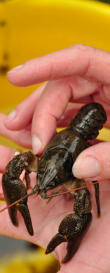
Volunteer with
Eden Rivers Trust
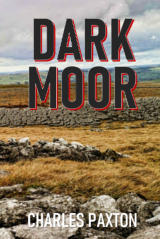
Charles Paxton’s new historical fantasy novel
“Dark Moor” is now available on Amazon
Kindle! The book is set in the Westmorland
Fells and some other noteworthy sites in
Cumbria.
Please click the above link or the cover image
to view the title in a new window.

© This site and its contents are copyright 2010-22 by C.Paxton and
other contributing members of the Westmorland Fells Group.


















